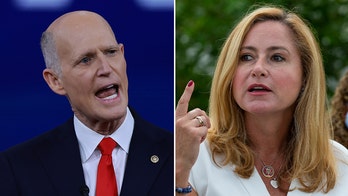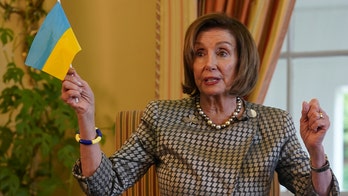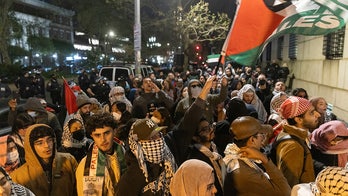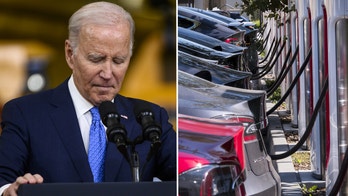I probably should have written this days ago.
I probably should have written this as the nation approached the ten-year anniversary of 9-11.
But frankly, it never hit me.
Sometimes, it takes a commemoration, a remembrance, a reflection - just like what the country has witnessed over the past few days - to jostle the mind and lubricate the brain synapses.
And then it comes to you.
I work daily in the U.S. Capitol covering Congress for FOX News.
And I've been wrong about something for for years. Been wrong as I lead tours of the Capitol. Misinforming people about a critical fact. Leaving something important out.
As a journalist who works here, I'm a little embarrassed.
I frequently lead impromptu tours of the Capitol for friends and family when they come to town. Sometimes the tours are even for people who live in Washington and never get to see things "behind-the-scenes" here. Sometimes, my tour groups are students. Other times, its foreign visitors.
And I've been wrong about something I've told them all for a long time.
During the tour, I show everyone the Rotunda, the House and Senate Radio-TV Galleries, and the place where the late-Sen. Ted Kennedy (D-MA) had his hideaway office. I show them where George Washington was supposed to be buried. They view the House and Senate chambers. Some get to come to the Speaker's Lobby itself, the long, ornate hallway that runs behind the dais in the House chamber. Time permitting, I even drag a few lucky ones through the Capitol attic.
And I almost always shuttle the visitors down to what's called the Memorial Door, an obscure entrance on the House side of the East Front of the Capitol.
Not much foot traffic comes by this spot. It's near the backdoor to the office suite now used by House Majority Whip Kevin McCarthy (R-CA). And about the only people who do enter the Capitol through here are top Congressional leaders like House Speaker John Boehner (R-OH) and Majority Leader Eric Cantor (R-VA). It's easy for them to get to their offices through this door once their security details drop them off outside.
But this door wasn't so off the beaten path 13 years ago. In those days, the passageway was called the "Document Door." Back then, it was a major point of ingress to the U.S. Capitol, used by lawmakers, aides and tourists alike.
The Document Door also used on July 24, 1998 by a paranoid schizophrenic named Russell Weston Jr. who unleashed a hale of bullets on the Capitol in a bloody, one-man siege.
Weston immediately shot and killed the U.S. Capitol Police officer guarding the Document Door, Officer Jacob "J.J." Chestnut. Weston then moved toward what is now McCarthy's office suite, occupied at the time by then House Majority Whip Tom DeLay (R-TX). Detective John Gibson was a plainclothes Capitol Police Detective, charged with protecting DeLay. Weston grievously wounded Gibson. But before he died, Gibson got off a shot that would have killed Weston had future Senate Majority Leader Bill Frist (R-TN), a heart surgeon, not saved his life.
In honor of Chestnut and Gibson, Congress renamed the Document Door the "Memorial Door." A plaque hangs on the wall nearby, embossed with pictures of the two slain officers.
"In honor and remembrance of the heroism displayed by Officer Jacob Joseph Chestnut and Detective John Michael Gibson, United States Capitol Police, who, on July 24, 1998, here bravely gave their lives defending the United States Capitol."
And this is where I've often escorted my guests and perpetrated a falsehood.
"These are the only two people ever killed defending the United States Capitol," I frequently say of Chestnut and Gibson.
Oh, but I am wrong. I am so, so wrong.
Chestnut and Gibson are the only people ever killed defending the Capitol on U.S. Capitol grounds.
The others killed defending the Capitol waged their crusade at 40,000 feet, somewhere near Cleveland. And they didn't perish in a doorjamb on the Capitol's East Front or on the floor in Tom DeLay's office.
They gave their lives defending the Capitol in Shanksville, PA.
These sentinels bore no badge like Chestnut and Gibson. They weren't protecting the U.S. Capitol with a string of Jersey barriers, hidden security cameras or high-powered assault rifles.
Their rampart was an airline food cart.
And even though they died, the U.S. Capitol still stands.
A plaque bearing the names of the passengers and crew of United Flight 93 hangs in the East Front Lobby of the Capitol. Perhaps best known from that heroic group are Mark Bingham, Jeremy Glick, Tom Burnett and Todd Beamer. Beamer of course is best known for uttering the words "Let's roll" to a GTE telephone operator before they stormed the cockpit.
Then-House Speaker Nancy Pelosi (D-CA) dedicated the Capitol memorial two years ago.
"With this plaque, the memories of those individuals will forever remain etched in the walls of the U.S. Capitol....for as long as this Capitol exists."
And the Capitol Dome still pierces the Washington skyline today because of the gallant souls aboard Flight 93.
"I know we're going to die," said Tom Burnett to his wife on a cell phone before they charged up the aisle behind the food cart.
In the cases of Officer Chestnut and Detective Gibson, they knew what they were defending. But had no idea they would die. The passengers aboard Flight 93 knew their fate, yet had no specific clue as to what they were defending.
John Boehner made a point of leading a Congressional delegation to Shanksville for Sunday's ceremony. With the Capitol as the target, Boehner felt it was only appropriate for the Constitutional officer of the legislative branch to appear there.
Last week, Rep. Bill Shuster (R-PA) introduced a bill that would issue a Congressional Gold Medal to all of those killed on 9-11, including those who died on Flight 93.
"The attacks took the lives of police, firemen, first responders and regular working Americans," Shuster said in a statement.
Fate conscripted "regular working Americans" to serve as guardians of the U.S. Capitol on that day ten years ago. They died defending a building in which some probably had never visited and certainly where none were employed.
This is not to subtract from the vigilant service of Chestnut and Gibson. It only serves as a stark reminder that those who defend the United States Capitol don't always toil under its Dome or in its marble halls. Anyone in the military knows that most of those who pay the ultimate price defending their country rarely do so in Washington.
They do it in Anbar Province. Kandahar. Normandy. Gettysburg.
And Shanksville, PA.
Wardens of democracy don't always wear a uniform.
Anniversaries of tragic events like September 11th serve to remind people about what happened and what was lost.
This anniversary sufficiently admonished me....that many gave their lives defending the United States Capitol.
And will now be recognized on my tours.




